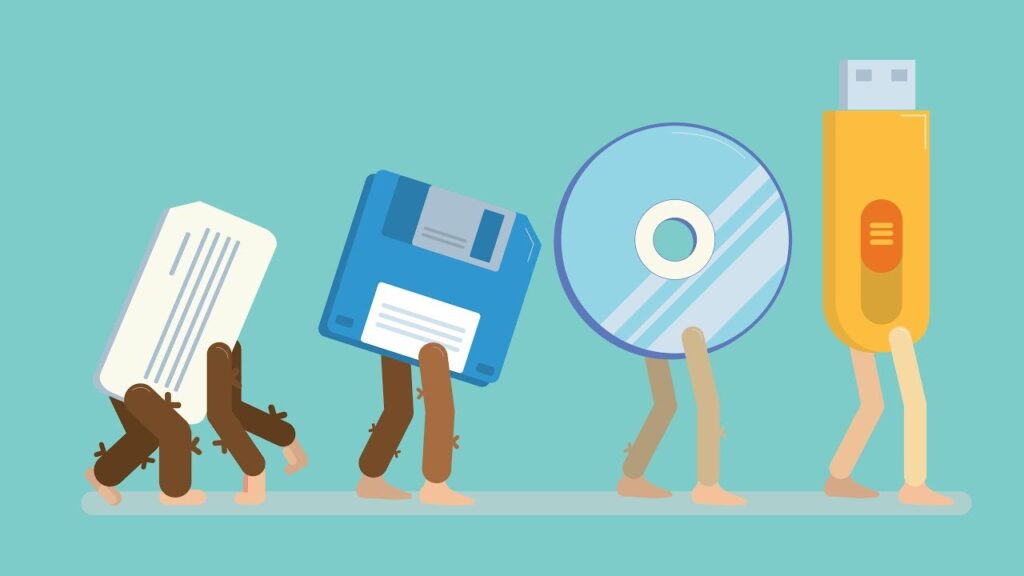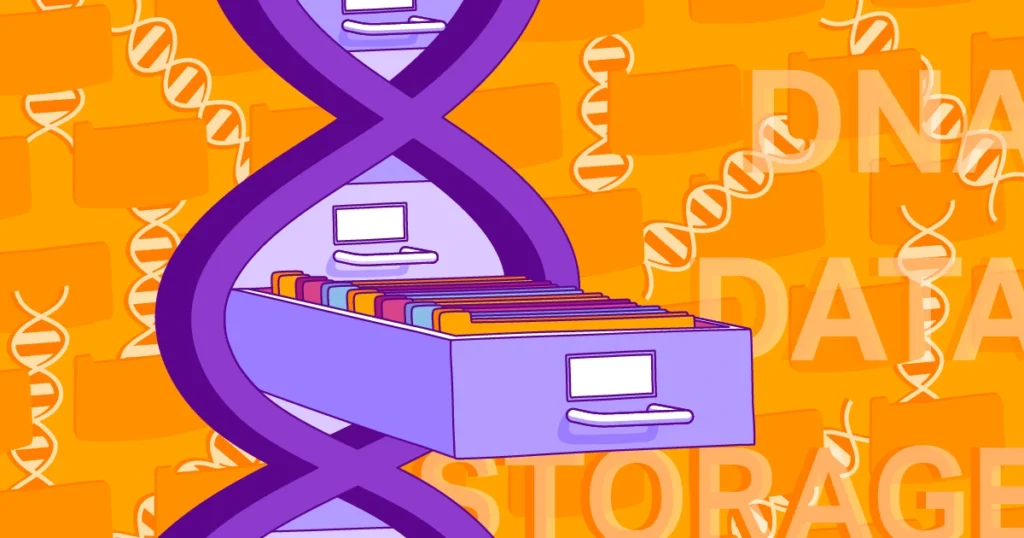Demystifying Traditional Data Storage Methods
Take me to the key takeaways...

Data storage refers to the methods and technologies used to record, preserve, and retrieve digital information. Over the decades, the mechanisms and media for data storage have undergone a transformative journey, shifting from the physical and tangible to the virtual and cloud-based, reflecting broader changes in technology and societal needs.
The evolution of data storage is a tale of constant innovation, marked by milestones from the rudimentary punch cards and magnetic tapes of the early computing era to the sophisticated solid-state drives and cloud-based solutions that dominate the world today. Each generation of storage technology has sought to address the growing demands for capacity, speed, reliability, and accessibility, driven by the exponential increase in data generation and consumption.
Modern storage solutions like cloud storage, network-attached storage (NAS), and object storage have taken center stage, offering scalable, flexible, and cost-effective alternatives to traditional storage methods. These modern approaches leverage the power of the internet and distributed computing to provide on-demand access to data from anywhere in the world, representing a significant shift from the physical limitations and locality of traditional storage.
Despite the allure of modern storage solutions, traditional data storage methods including encompassing magnetic, optical, and early solid-state technologies, remain relevant and widely used in various contexts. These traditional methods offer distinct advantages in terms of data security, and specific performance metrics, making them indispensable in some scenarios and industries.

Traditional data storage describes a variety of physical media used to store digital information. Unlike modern cloud-based solutions that store data in virtualised environments, traditional storage relies on physical devices and media that must be manually managed and maintained. Traditional data storage methods include:
Magnetic storage devices store data by magnetising particles on a disk or tape surface. Hard drives (HDDs) and tape drives are common examples:
Optical storage devices use lasers to read and write data on discs made of polycarbonate plastic, coated with a reflective layer. CDs (Compact Discs) and DVDs (Digital Versatile Discs) are the most prevalent forms:
Solid-state storage represents a shift from moving mechanical parts to electronic data storage. Early SSDs (Solid-State Drives) and flash drives store data on flash memory chips:
Despite the advancements in cloud and networked storage technologies, traditional data storage methods remain vital in numerous scenarios, from high-security environments requiring physical data control to applications where rapid local access to data is crucial. Understanding these technologies and their characteristics helps in making informed decisions about storage solutions that best meet specific needs and constraints.

The history of data storage is a fascinating journey through time, showcasing human ingenuity and the relentless pursuit of better, faster, and more efficient ways to preserve information. From the humble beginnings of manual data recording to the sophisticated digital solutions of today, each advancement in storage technology has been a response to the growing demands of data creation and consumption.
The story of data storage begins with punch cards, used in the early 18th century for controlling textile looms. However, their significance in data storage was realised in the 19th century when Herman Hollerith developed a punch card system to process the 1890 U.S. Census data. This system dramatically reduced processing time from years to months, demonstrating the potential of mechanical data storage.
The next significant leap was the development of magnetic tape in the 1950s. Inspired by magnetic audio recording, magnetic tape allowed for much greater data density and faster access times than punch cards. Its portability and reusability made it a mainstay for data backup, archival, and even primary storage in the early days of computing.
The invention of the hard disk drive (HDD) in 1956 by IBM marked a pivotal moment in data storage, introducing random access storage and significantly increasing storage capacity and speed. The first HDD, the IBM 305 RAMAC, could store 5 million characters (about 5MB) and was the size of two refrigerators. This innovation laid the groundwork for the development of smaller, more efficient drives, leading to the widespread adoption of HDDs in both personal and enterprise computing environments.
As the digital age dawned, the need for higher-capacity, portable storage led to the development of optical storage technologies, such as CDs and DVDs, in the late 20th century. These media could store vast amounts of data compared to magnetic tapes and disks, with the added advantage of being immune to magnetic fields and environmental damage. CDs and DVDs became popular for distributing software, music, movies, and for personal data storage due to their durability and capacity.
The introduction of solid-state drives (SSDs) in the 21st century represented a significant technological leap. By storing data on flash memory chips rather than magnetic or optical media, SSDs offered faster data access times, lower power consumption, and greater durability. Despite their higher cost, SSDs have become increasingly popular for both consumer and enterprise applications, offering a glimpse into the future of data storage.
Each of these storage methods was revolutionary in its time, addressing the specific needs and technological limitations of the era. Punch cards offered a way to automate and speed up data processing; magnetic tape and HDDs increased storage capacity and access speed; optical media improved portability and durability; and SSDs have pushed the boundaries of speed and efficiency.
Today's requirements for data storage are built around the need for immense capacity, lightning-fast access speeds, and the flexibility to access data from anywhere. While cloud storage and advanced SSDs meet many of these demands, the legacy of traditional storage methods remains embedded in the fabric of current technologies. Their evolution reflects broader progress, with each innovation building on the last to create complex, interconnected modern data storage.

Cloud-based solutions often dominate the conversation around data storage, but traditional data storage methods continue to offer distinct advantages for businesses. These benefits are not merely relics of past practices but are highly relevant in addressing specific operational, financial, and security considerations in today's business environments. This section explores the enduring advantages of traditional storage methods that remain in use, such as magnetic storage (HDDs, tape drives) and solid-state drives (SSDs), focusing on cost implications, data sovereignty and security, and performance considerations for specific applications.
While cloud-based storage solutions have become popular for their scalability and convenience, traditional data storage methods retain significant advantages for businesses. The choice between traditional and cloud storage should be guided by a comprehensive assessment of a business's specific needs, regulatory requirements, performance demands, and cost considerations. For many organisations, the optimal solution may involve a hybrid approach, leveraging the strengths of both traditional and cloud storage to achieve a balanced, efficient, and secure data storage strategy.
While traditional data storage methods offer significant advantages in terms of cost, data sovereignty, and performance for specific applications, they are not without their challenges. As businesses navigate the complex landscape of data management, understanding the limitations of traditional storage is crucial for making informed decisions. This section delves into the primary challenges associated with traditional data storage methods that are still in use today, such as magnetic storage (HDDs, tape drives) and solid-state drives (SSDs), focusing on scalability, maintenance and reliability, and the implications of energy consumption and physical space requirements.
The challenges associated with traditional data storage underscore the importance of a strategic approach to data management. Businesses must weigh the benefits of cost, control, and performance against the challenges of scalability, maintenance, and operational efficiency. As the digital economy continues to evolve, and data becomes increasingly central to business operations, finding the right balance between traditional and modern storage solutions will be key to navigating these challenges effectively. For many, this may involve adopting hybrid models that leverage the strengths of both worlds, ensuring that data storage strategies are not only robust and secure but also adaptable and scalable.
In the quest to optimise data storage strategies, businesses often weigh the merits of traditional storage methods against the capabilities of cloud storage solutions. This comparative analysis delves into five key parameters: cost, scalability, security, performance, and ease of management, providing insights into how traditional and cloud storage stack up against each other. Additionally, we'll explore specific use cases where traditional storage might still hold an advantage over cloud solutions.
| Traditional Storage | Cloud Storage | |
|---|---|---|
| Cost | - Higher upfront investment in physical hardware. - Potentially lower long-term costs for stable storage needs. | - Lower upfront costs with subscription-based pricing. - Costs can scale with usage, potentially higher for extensive data storage needs. |
| Scalability | - Limited by physical capacity; requires additional hardware for expansion. | - Highly scalable; resources can be adjusted dynamically to meet demand. |
| Security | - High level of physical control and security over data. - Data sovereignty is easier to manage. | - Robust security measures in place, but concerns over data breaches and privacy. - Compliance with data sovereignty laws depends on provider's data center locations. |
| Performance | - Fast access speeds in local networks without dependence on internet connectivity. - Predictable performance for specific applications. | - Performance can be influenced by internet speed and connectivity. - Potentially variable performance due to shared resources. |
| Ease of Management | - Requires manual management and maintenance of physical hardware. | - Outsourced infrastructure management; less hands-on maintenance required. |
While cloud storage provides scalable, flexible, and maintenance-free storage solutions, traditional storage methods remain relevant and superior in specific contexts. The choice between traditional and cloud storage should be informed by a detailed assessment of an organisation's specific needs, regulatory environment, performance requirements, and cost considerations. A hybrid approach, leveraging the strengths of both traditional and cloud storage, often represents the most balanced and effective strategy for modern data management needs.

We are approaching a new era in data storage technology. Emerging trends and technologies, such as holographic storage and DNA storage, pose a future where the limitations of current storage methods could be transcended, offering unparalleled capacities and durability.
Not just yet. Despite the rapid advancements in technology that have ushered in the era of cloud storage, the relevance of traditional data storage methods persists, underscoring their indispensable role in specific industries and businesses. This enduring significance is not just a head-nod to the past but a reflection of the nuanced requirements of data storage that vary across industries, applications, and operational frameworks.
Traditional storage methods, including magnetic storage (HDDs, tape drives) and solid-state drives (SSDs), offer distinct advantages such as cost-effectiveness in long-term archival scenarios, superior performance in high-speed access environments, enhanced security for sensitive data, and unparalleled data sovereignty. These benefits remain critical for businesses operating in sectors where regulatory compliance, data privacy, and operational autonomy are paramount. Furthermore, in scenarios characterised by limited internet connectivity or the need for rapid data access within closed networks, traditional storage solutions stand unmatched.
Understanding the intricacies of traditional data storage is crucial for making informed decisions in a time where the temptation to leap towards the latest technology can overlook the specific needs of a business. The choice between traditional and cloud storage should not be seen as a binary one but rather as a strategic decision that considers a spectrum of factors including cost, scalability, security, performance, and management ease. For many organisations, a hybrid approach that marries the scalability and flexibility of cloud storage with the reliability and control of traditional methods offers a balanced path forward.
As we look towards the future, the evolution of traditional storage methods and their integration into next-generation solutions will continue to be shaped by emerging trends and technologies. This evolution will not render traditional storage obsolete but will instead redefine its role within the broader ecosystem of data storage solutions. The journey of data storage is one of continuous adaptation, where understanding the foundations of traditional methods enriches our capacity to navigate the future.